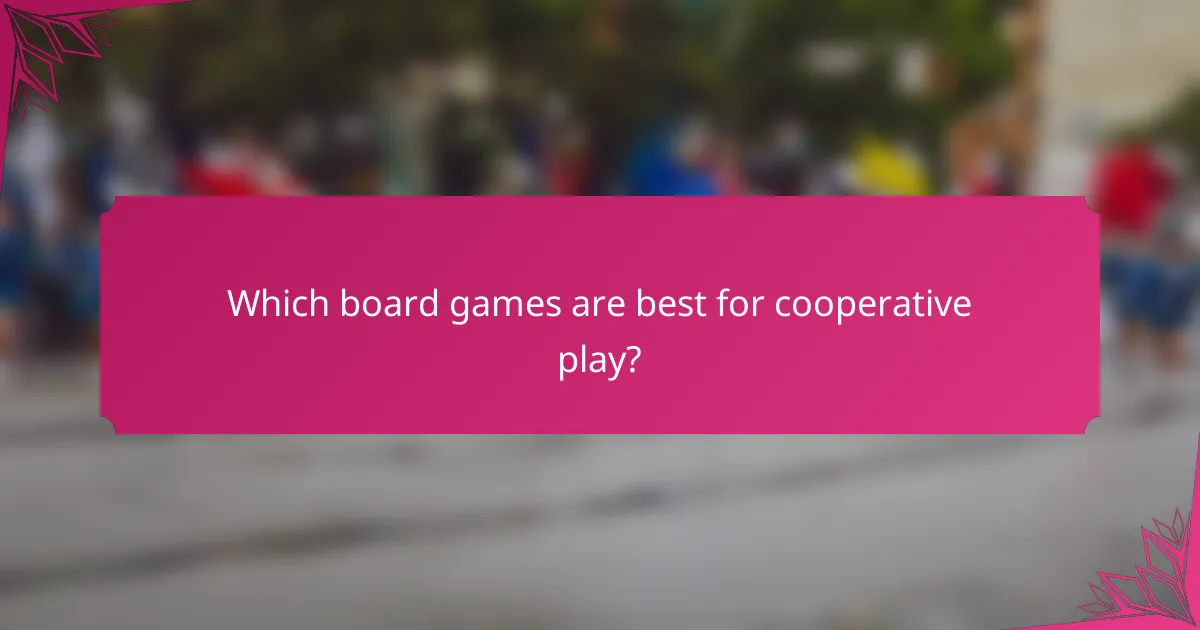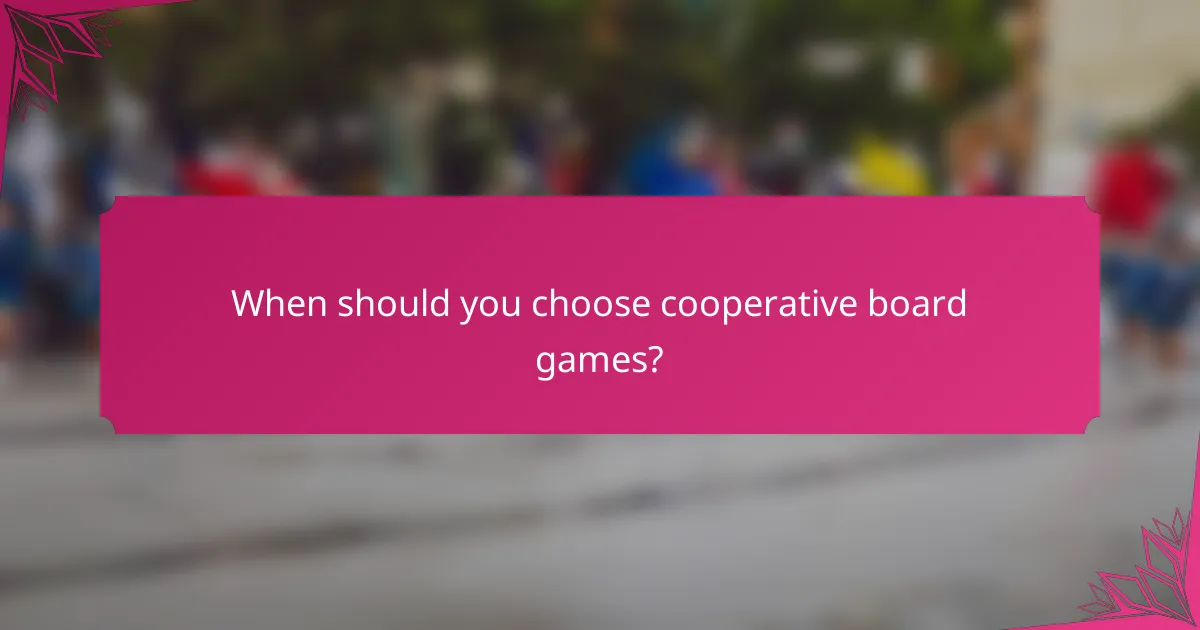When choosing between cooperative and competitive board games, it’s essential to consider the desired player experience. Cooperative games promote teamwork and collaboration, making them perfect for fostering relationships, while competitive games focus on strategy and player interaction, encouraging individuals to outsmart one another. Understanding the context and goals of your game night can help determine which style is more suitable for your group.

Which board games are best for cooperative play?
Cooperative board games encourage players to work together towards a common goal, making them ideal for fostering teamwork and collaboration. Popular choices include games that challenge players to strategize collectively against the game itself rather than competing against each other.
Pandemic
Pandemic is a classic cooperative game where players take on the roles of specialists working to stop the spread of diseases across the globe. Each player has unique abilities that contribute to the team’s efforts, making strategic planning essential. The game typically lasts around 45 minutes and can accommodate 2 to 4 players.
To succeed in Pandemic, players must communicate effectively and plan their moves carefully. Failing to coordinate can lead to outbreaks, making it crucial to prioritize actions that contain the spread of diseases. A common pitfall is focusing too much on individual roles rather than the team’s overall strategy.
Forbidden Island
Forbidden Island is a family-friendly cooperative game where players work together to collect treasures and escape from a sinking island. It is designed for 2 to 4 players and usually takes about 30 minutes to play. The game is accessible to younger audiences while still offering strategic depth for adults.
In Forbidden Island, players must balance their actions between collecting treasures and moving to safety. Effective teamwork is vital, as players can share cards and assist each other in navigating the island. A key tip is to keep an eye on the water levels, as the island’s tiles can disappear quickly, increasing the urgency of decisions.
Spirit Island
Spirit Island is a more complex cooperative game where players embody spirits defending their island from colonizing invaders. This game is suitable for 1 to 4 players and can take 90 to 120 minutes to complete, making it ideal for dedicated game nights.
Success in Spirit Island relies heavily on understanding each spirit’s unique powers and how they can synergize with others. Players must strategize not only to repel invaders but also to empower the island’s native inhabitants. A common mistake is underestimating the invaders’ growth, so players should regularly assess the board state and adjust their strategies accordingly.

Which board games are best for competitive play?
Competitive board games often emphasize strategy, resource management, and player interaction. Popular choices for competitive play include games that challenge players to outsmart each other while achieving specific objectives.
Catan
Catan is a classic competitive game where players collect resources to build settlements and cities. The game involves trading and negotiation, making player interaction crucial. Each game can vary significantly based on the initial setup and player strategies, leading to diverse experiences.
To succeed in Catan, focus on resource diversity and strategic placement of settlements. Avoid monopolizing one resource, as this can limit your options and make you vulnerable to trades with opponents.
Risk
Risk is a strategic board game centered on world domination through military conquest. Players control armies and engage in battles to capture territories, with the goal of eliminating opponents. The game requires tactical planning and alliances, which can shift throughout play.
In Risk, be mindful of your positioning and alliances. Form temporary partnerships to eliminate stronger players, but be prepared for betrayal. A balanced approach to offense and defense can help maintain your standing in the game.
Ticket to Ride
Ticket to Ride is a competitive game where players build train routes across a map to connect cities and complete destination tickets. The game combines strategy with a bit of luck, as players draw cards to claim routes. Timing and route planning are key to winning.
To excel in Ticket to Ride, prioritize completing your longest routes while blocking opponents from critical connections. Keep an eye on the cards available and adapt your strategy based on your opponents’ moves.

When should you choose cooperative board games?
Cooperative board games are ideal when the goal is to foster collaboration and teamwork among players. They work best in settings where building relationships and working together towards a common objective is more valuable than individual competition.
Team-building events
Cooperative board games are excellent for team-building events as they encourage communication and problem-solving among participants. Games like “Pandemic” or “Forbidden Island” require players to strategize together, which can strengthen bonds and improve group dynamics.
When selecting a game for a team-building event, consider the size of the group and the time available. Aim for games that accommodate larger teams and can be completed in under two hours to maintain engagement and focus.
Family game nights
For family game nights, cooperative board games can create a fun and inclusive atmosphere where everyone works towards a shared goal. Games such as “Ghost Fightin’ Treasure Hunters” or “Outfoxed!” are suitable for families with children, promoting teamwork without the pressure of competition.
Choose games that match the age range of family members to ensure everyone can participate. Look for games that allow for varying levels of difficulty, so they can be adjusted to suit different skill levels and keep the experience enjoyable for all.
Educational settings
In educational settings, cooperative board games can enhance learning by promoting collaboration and critical thinking. Games like “The Game of Life” or “Catan” can be used to teach subjects such as economics, strategy, and social interaction.
When implementing these games in classrooms, consider the learning objectives and the age of the students. Games that require teamwork can help develop social skills and encourage a positive learning environment, making them a valuable tool for educators.

When should you choose competitive board games?
Competitive board games are ideal when players are looking for a challenge and enjoy direct interaction with others. These games often foster a spirited atmosphere, making them suitable for specific social settings and gatherings.
Game nights with friends
Competitive board games can energize game nights with friends, creating a lively and engaging environment. They encourage players to strategize against each other, which can lead to memorable moments and friendly rivalries. Popular choices include games like “Catan” or “Ticket to Ride,” which balance competition with accessibility.
Consider the group’s dynamics; if everyone enjoys a bit of rivalry, competitive games can enhance the fun. However, ensure that the competitive nature doesn’t lead to frustration among less experienced players.
Strategy-focused gatherings
If your gathering emphasizes strategic thinking, competitive board games are a perfect fit. Games such as “Terraforming Mars” or “Scythe” require players to plan their moves carefully while anticipating opponents’ strategies. These games often involve deeper mechanics, making them suitable for players who enjoy complex decision-making.
When selecting a game, consider the group’s familiarity with strategy games. It may be beneficial to introduce lighter competitive games first before moving on to more intricate options.
Adult parties
At adult parties, competitive board games can serve as an excellent icebreaker and entertainment option. They can facilitate interaction among guests who may not know each other well, fostering connections through gameplay. Games like “Codenames” or “Wits & Wagers” are great for mixed groups, as they combine competition with social interaction.
Keep in mind the atmosphere you want to create; overly intense games may not suit a relaxed gathering. Opt for games that encourage laughter and conversation while still maintaining a competitive edge.

What are the key differences between cooperative and competitive board games?
Cooperative board games require players to work together towards a common goal, while competitive board games pit players against each other to achieve individual victory. Understanding these differences can help players choose the right type of game for their group dynamics and preferences.
Player interaction styles
In cooperative board games, player interaction is typically collaborative, with participants sharing strategies and resources to overcome challenges. This fosters teamwork and communication, as players must coordinate their actions to succeed.
Conversely, competitive board games encourage a more adversarial interaction style, where players often engage in direct competition. This can lead to negotiation, alliances, or even betrayal, depending on the game’s mechanics and player strategies.
Game objectives
The objective in cooperative games is to achieve a shared goal, such as defeating a common enemy or completing a mission before time runs out. Success relies on collective effort, making the experience more about the journey than individual accolades.
In competitive games, each player aims to outmaneuver others to secure victory, often through accumulating points or resources. This creates a focus on personal achievement and can lead to varied strategies based on player strengths and weaknesses.
Winning conditions
Winning conditions in cooperative games are generally defined by the group’s ability to meet specific criteria, such as completing tasks or surviving challenges. If the group fails to meet these conditions, everyone typically loses together.
In competitive games, winning conditions are individualistic, with players striving to be the first to reach a target score or complete a set of objectives. This often results in a clear winner, while others may feel the sting of defeat, making the stakes feel higher for each participant.
